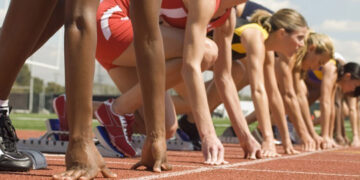In the world of elite sports, raw talent alone is no longer enough to guarantee success. Behind every great athlete is a team of scientists, coaches, nutritionists, and analysts who use cutting-edge science to refine every detail of performance. From biomechanics to brain training, modern athletes rely on scientific strategies to stay ahead of the competition.
In this blog, we’ll explore the science behind sports performance and uncover how today’s top athletes remain in peak condition, both physically and mentally.
1. Biomechanics: Optimizing Movement and Technique
Biomechanics is the study of human motion, and it plays a critical role in enhancing athletic performance.
How it works:
-
Motion capture technology tracks body movements in real time.
-
High-speed cameras and sensors analyze joint angles, muscle engagement, and stride patterns.
-
Coaches use this data to correct form, increase efficiency, and reduce injury risk.
Example:
Sprinters work with biomechanics experts to perfect their start, stride, and acceleration—shaving milliseconds off their time, which can mean the difference between winning and losing.
2. Sports Psychology: Mastering the Mental Game
Mental toughness can be just as important as physical strength. Sports psychology helps athletes manage pressure, boost focus, and maintain confidence.
Techniques commonly used:
-
Visualization and mental imagery
-
Breathing exercises and mindfulness
-
Goal-setting and performance routines
Real-world application:
Tennis players like Novak Djokovic use visualization to mentally rehearse points before matches, allowing them to react instinctively under pressure.
3. Nutrition and Hydration: Fueling Peak Performance
What athletes eat and drink directly impacts their performance, recovery, and endurance.
Key components:
-
Macronutrient balance (carbs, proteins, fats)
-
Timing of meals before and after training
-
Hydration plans based on sweat rate and climate
Advanced strategies:
-
Personalized nutrition based on genetic testing
-
Use of supplements like creatine, beta-alanine, and electrolytes
-
Anti-inflammatory foods to support recovery
Example:
Marathon runners often “carb load” in the days before a race to maximize glycogen stores, providing sustained energy for long-distance running.
4. Sleep Science: The Power of Recovery
Sleep is when the body repairs itself, and athletes treat it as a vital part of training.
Benefits of quality sleep for athletes:
-
Enhanced muscle recovery and hormone production
-
Improved reaction times and decision-making
-
Reduced injury risk and mental fatigue
Sleep optimization methods:
-
Consistent sleep schedules
-
Use of sleep trackers (e.g., WHOOP, Oura Ring)
-
Blackout curtains and no-screen policies before bed
Fact:
Studies show that basketball players who increase their sleep to 9–10 hours per night improve free-throw and 3-point shooting accuracy.
5. Strength and Conditioning: Building the Athletic Engine
Strength and conditioning programs are carefully crafted to match the demands of each sport.
Elements of effective programs:
-
Sport-specific movements (e.g., plyometrics for basketball, core training for rowing)
-
Periodization: structured cycles of training intensity and volume
-
Injury prevention through mobility and balance work
Tools used:
-
Force plates to measure power output
-
Velocity-based training devices
-
Wearable tech to track reps, sets, and heart rate
Example:
NFL players use explosive lifts like the power clean to build speed and strength, which translates directly into on-field performance.
6. Data Analytics and Wearable Technology
Modern athletes are often monitored 24/7, and every movement is converted into usable data.
Popular wearables:
-
GPS trackers (measure distance, speed, and direction)
-
Heart rate monitors (assess intensity and recovery)
-
Sleep and readiness rings/watches
Coaches analyze:
-
Load management to prevent overtraining
-
Real-time in-game performance
-
Long-term trends to guide training adaptations
Example:
Soccer teams like Manchester City use GPS vests and data dashboards to track players’ workloads and adjust training accordingly.
7. Recovery Techniques: Staying Fresh and Injury-Free
Training hard is only half the equation—recovering properly is just as important.
Top recovery methods:
-
Cryotherapy and ice baths
-
Compression garments
-
Massage therapy and foam rolling
-
Red light therapy and contrast showers
Why it matters:
Rapid recovery allows athletes to train more frequently and with higher intensity, leading to better overall performance.
8. Altitude and Environment Training
Many athletes train at high altitudes or in simulated environments to gain a competitive edge.
Benefits of altitude training:
-
Increases red blood cell count
-
Improves oxygen delivery to muscles
-
Enhances endurance
Other environmental tactics:
-
Heat training to improve sweat efficiency
-
Hypoxic chambers that simulate different altitudes
-
Acclimatization before events in extreme weather
Example:
Olympic distance runners from Kenya often train in the high-altitude regions of the Rift Valley for superior cardiovascular conditioning.
9. Injury Prevention and Rehabilitation
No athlete can afford to miss a season due to preventable injury. Sports science focuses heavily on injury risk reduction.
Key techniques:
-
Functional Movement Screening (FMS)
-
Prehab (preventive rehab exercises)
-
Video analysis to detect asymmetries
In case of injury:
-
Advanced rehab protocols using hydrotherapy, anti-gravity treadmills, and isokinetic machines help accelerate return to play.
Example:
Top clubs like FC Barcelona have dedicated recovery centers with real-time diagnostics to manage athlete wellness proactively.
10. Genetic Testing and Personalized Training
Cutting-edge sports science now includes DNA-based performance profiling.
What genes can reveal:
-
Muscle fiber type (power vs. endurance)
-
Injury susceptibility
-
Nutrient processing efficiency
Benefit:
Customizing training and nutrition plans based on genetic data helps unlock an athlete’s full potential.

















